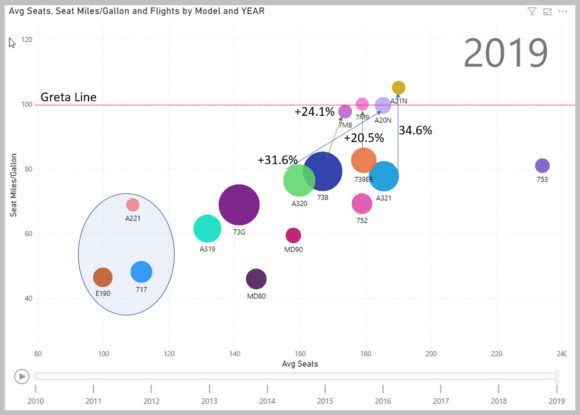
2020 01 16 11 43 35
With a recent data update from DoT and an idea from a reader, we took a look at how flight stage length, seat capacity, and fuel burn looked across the US airline fleet. The timing of this idea came up just as Airbus spoke about A330neo production. At the same event where Christian Scherer spoke, Air Canada people did not want to talk about MAX. The airline people were focused on their new airplane – whose seating is about the same as its A319s.
While we have modeled the data (subscribers have access), here is a summary of the findings for 3Y19. The Y-axis shows fuel burn per seat mile. The X-axis shows average seating.
The new generation of aircraft show exceptionally improved fuel burn. The “Greta Line” is our euphemistic name (in honor of a mythical aerospace expert) given to the 100 seat mile per gallon line. The neo and MAX are all on or above that line. Could we refer to these as “Greta compliant”?
- In its class the A220-100 competes with, it is now achieving the same level of fuel burn per seat as a 737-700. That the A220 will be disruptive is clear. We estimate the A220-300 should also have a leap in fuel burn above its peers the A319 and 737-700. Being an early adopter (and locking out slots for competitors) was a great move by Delta.
- Airbus
- Comparing the Airbus A320ceo to neo we see a staggering 31.6% seat mile per gallon improvement. This is because the neo does indeed have a better fuel burn, but also because the US neo fleet is influenced by Spirit and Frontier seating. The A320ceo average is 160 seats while the A320neo average is 185. Only these ULLCs operate the A320neo in the US at present.
- For the A321 the news is also good – the A321neo is King of the Hill. It is the fuel burn leader. It is also clear why the US airline industry is moving towards this model whether regular, neo, LR or XLR. The A321ceo to A321neo sees an improvement of 34.6%. Seating rises from an average of 186 to 190, so the impact from LCC tight pitch is lower than we see from the A320neo.
- Boeing
- The 737-800 to MAX8 sees an improvement of 24.1%. Average seating rises from 167 to 174 which explains some of the improvements.
- The 737-900ER to MAX (sees an improvement of 20.5%. Average seating sees no change from 179. Readers will note the 757-200 also averages 179 seats. In fuel seat mile per gallon terms, the MAX9 is 44.9% better than the 757-200. This could be a basis for Boeing arguing the MAX9 is indeed the natural 757-200 replacement. A fair statement if the market stod still, but it has not.
Just for another perspective here we can see how these aircraft perform in terms of fuel burn and average stage length.
- The advantage offered by the A321neo is clear. It is also clear why the MAX9 is not a replacement for the 757-200, whereas the A321neo could be.
- The re-engined models are doing well in fuel burn terms – living up to their promise. The MAX8 and A320neo are neck and neck. The MAX8 gets two miles more in seat miles per gallon.
- The A220-100 demonstrates how it is fulfilling the promise Bombardier made. This is very impressive and we are eager to see how the A220-300 does in light of these numbers. We are equally keen to see where the E2 shows up when that fleet enters US service and its numbers become available.
Subscribers are able to see these numbers for twin aisles. For the twin aisles, we also have data on freight and mail as that is a significant item for these aircraft.
Views: 24






